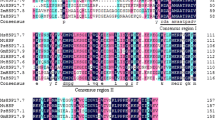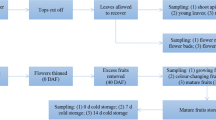Abstract
Small heat shock proteins (sHSPs) are the critical components of responses to various environmental stresses. However, few have been functionally characterised in Primula. In this study, we cloned a sHSP gene, PfHSP17.1, which is highly up-regulated in the leaves of Primula forrestii exposed to thermal stress (42 °C for 2 h). Sequence alignment and phylogenetic analysis indicated that PfHSP17.1 is a member of the plant cytosolic class I sHSPs. This gene was basally and ubiquitously expressed in different plant organs. The expression of PfHSP17.1 was also triggered remarkably by salt, drought and oxidative stress conditions but was only slightly induced by abscisic acid. Transgenic Arabidopsis thaliana constitutively expressing PfHSP17.1 displayed increased thermotolerance and higher resistance to salt and drought compared with wild-type plants. These results highlight the important role that PfHSP17.1 plays in diverse physiological and biochemical processes related to adverse conditions.






Similar content being viewed by others
Abbreviations
- ABA:
-
Abscisic acid
- CaMV:
-
Cauliflower mosaic virus
- EST:
-
Expressed sequence tag
- MDA:
-
Malondialdehyde
- ORF:
-
Open reading frame
- PEG:
-
Polyethylene glycol
- RACE:
-
Rapid-amplification of cDNA ends
- sHSP:
-
Small heat shock protein
- SOD:
-
Superoxide dismutase
- WT:
-
Wild type
References
Ahn YJ, Zimmerman JL (2006) Introduction of the carrot HSP17.7 into potato (Solanum tuberosum L.) enhances cellular membrane stability and tuberization in vitro. Plant Cell Environ 29:95–104
Bates LS, Waldren RP, Teare ID (1973) Rapid determination of free proline for water-stress studies. Plant Soil 39:205–207
Campbell JL, Klueva NY, Zheng HG, Nieto-Sotelo J, Ho TD, Nguyen HT (2001) Cloning of new members of heat shock protein HSP101 gene family in wheat (Triticum aestivum (L.) Moench) inducible by heat, dehydration, and ABA. Biochim Biophys Acta 1517:270–277
Charng Y, Liu H, Liu N, Hsu F, Ko S (2006) Arabidopsis Hsa32, a novel heat shock protein, is essential for acquired thermotolerance during long recovery after acclimation. Plant Physiol 140:1297–1305
Chauhan H, Khurana N, Nijhavan A, Khurana JP, Khurana P (2012) The wheat chloroplastic small heat shock protein (sHSP26) is involved in seed maturation and germination and imparts tolerance to heat stress. Plant Cell Environ 35:1912–1931
Clough SJ, Bent AF (1998) Floral dip: a simplified method for Agrobacterium-mediated transformation of Arabidopsis thaliana. Plant J 16:735–743
Coca MA, Almoguera C, Thomas TL, Jordano J (1996) Differential regulation of small heat-shock genes in plants: analysis of a water-stress-inducible and developmentally activated sunflower promoter. Plant Mol Biol 135:432–443
Dhindsa RA, Plumb-Dhindsa P, Thorpe TA (1981) Leaf Senescence: correlated with increased levels of membrane permeability and lipid peroxidation, and decreased levels of superoxide dismutase and catalase. J Exp Bot 126:93–101
Gao C, Jiang B, Wang Y, Liu G, Yang C (2012) Overexpression of a heat shock protein (ThHSP18.3) from Tamarix hispida confers stress tolerance to yeast. Mol Biol Rep 39:4889–4897
Helm KW, Schmeits J, Vierling E (1995) An endomembrane-localized small heat-shock protein from Arabidopsis thaliana. Plant Physiol 107:287–288
Hong SW, Vierling E (2000) Mutants of Arabidopsis thaliana defective in the acquisition of tolerance to high temperature stress. Proc Natl Acad Sci USA 97:4392–4397
Hu W, Zhang Q, Pan H, Dong L (2010) Preliminary study on physiological indexes of heat-resistance of primula. Chin Agric Sci Bull 26:158–163
Jiang C, Xu J, Zhang H, Zhang X, Shi J, Li M, Ming F (2009) A cytosolic class I small heat shock protein, RcHSP17.8, of Rosa chinensis confers resistance to a variety of stresses to Escherichia coli, yeast and Arabidopsis thaliana. Plant Cell Environ 32:1046–1059
Lenne C, Block MA, Garin J, Douce R (1995) Sequence and expression of the mRNA encoding HSP22, the mitochondrial small heat-shock protein in pea leaves. Biochem J 311:805–813
Lindquist S, Craig E (1988) The heat shock proteins. Annu Rev Genet 22:631–677
Ma CL, Haslbeck M, Babujee L, Jahn O, Reumann S (2006) Identification and characterization of a stress-inducible and a constitutive small heat-shock protein targeted to the matrix of plant peroxisomes. Plant Physiol 141:47–60
Mahmood T, Safdar W, Abbasi BH, Naqvi SMS (2010) An overview on the small heat shock proteins. Afr J Biotechnol 9:927–949
Maimbo M, Ohnishi K, Hikichi Y, Yoshioka H, Kiba A (2007) Induction of a small heat shock protein and its functional roles in Nicotiana plants in the defense response against Ralstonia solanacearum. Plant Physiol 145:1588–1599
Murakami T, Mastuba S, Funatsuki H, Kawaguchi K, Saruyama H, Tanida M, Sato Y (2004) Over-expression of a small heat shock protein, sHSP17.7, confers both heat tolerance and UV-B resistance to rice plants. Mol Breed 13:165–175
Narberhaus F (2002) α-Crystallin-type heat shock proteins: socializing minichaperones in the context of a multichaperone network. Microbiol Mol Biol Rev 66:64–93
Nieto-Sotelo J, Kannan KB, Martinez LM, Segal C (1999) Characterization of a maize heat-shock protein 101 gene, HSP101, encoding a ClpB/Hsp100 protein homologue. Gene 230:187–195
Parsell DA, Kowal A, Singer MA, Lindquist S (1994) Protein disaggregation mediated by heat-shock protein Hsp104. Nature 372:475–478
Perez DE, Hoyer JS, Johnson AI, Moody ZR, Lopez J, Kaplinsky NJ (2009) BOBBER1 is a noncanonical Arabidopsis small heat shock protein required for both development and thermotolerance. Plant Physiol 151:241–252
Richards AJ (1993) Primula. B. T. Batsford, London, p 299
Sanmiya K, Suzuki K, Egawa Y, Shono M (2004) Mitochondrial small heat-shock protein enhances thermotolerance in tobacco plants. FEBS Lett 557:265–268
Sato Y, Yokoya S (2008) Enhanced tolerance to drought stress in transgenic rice plants overexpressing a small heat-shock protein, sHSP17.7. Plant Cell Rep 27:329–334
Sharom M, Willemot C, Thompson JE (1994) Chilling injury induces lipid phase changes in membranes of tomato fruit. Plant Physiol 105:305–308
Song L, Jiang Y, Zhao H, Hou M (2012) Acquired thermotolerance in plants. Plant Cell Tiss Organ Cult 111:265–276
Sun W, Bernard C, van de Cotte B, van Montagu M, Verbruggen N (2001) At-HSP17.6A, encoding a small heat-shock protein in Arabidopsis, can enhance osmotolerance upon overexpression. Plant J 27:407–415
Vierling E (1991) The roles of heat shock proteins in plants. Annu Rev Plant Physiol Plant Mol Biol 42:579–620
Wang WX, Vinocur B, Shoseyov O, Altman A (2004) Role of plant heat-shock proteins and molecular chaperones in the abiotic stress response. Trends Plant Sci 9:244–252
Waters ER, Lee GJ, Vierling E (1996) Evolution, structure and function of the small heat shock proteins in plants. J Exp Bot 47:325–338
Xue Y, Peng R, Xiong A, Li X, Zha D, Yao Q (2010) Over-expression of heat shock protein gene hsp26 in Arabidopsis thaliana enhances heat tolerance. Biol Plant 54:105–111
Zhang XX, Liu SK, Takano T (2008) Two cysteine proteinase inhibitors from Arabidopsis thaliana, AtCYSa and AtCYSb, increasing the salt, drought, oxidation and cold tolerance. Plant Mol Biol 68:131–143
Zhou YL, Chen HH, Chu P, Li Y, Tan B, Ding Y, Tsang EWT, Jiang LW, Wu KQ, Huang SZ (2012) NnHSP17.5, a cytosolic class II small heat shock protein gene from Nelumbo nucifera, contributes to seed germination vigor and seedling thermotolerance in transgenic Arabidopsis. Plant Cell Rep 31:379–389
Zou J, Liu A, Chen X, Zhou X, Gao G, Wang W, Zhang X (2009) Expression analysis of nine rice heat shock protein genes under abiotic stresses and ABA treatment. J Plant Physiol 166:851–861
Acknowledgments
This work was supported by the Ministry of Science and Technology (No. 2012BAD01B07).
Author information
Authors and Affiliations
Corresponding author
Additional information
Communicated by J.-H. Liu.
Electronic supplementary material
Below is the link to the electronic supplementary material.

11738_2013_1354_Fig7_ESM.jpg
Supplementary Fig. S1 Semi-quantitative RT-PCR of expression of PfHSP17.1 in P. forrestii under ABA treatment. The semi-quantitative RT-PCR was performed with the following amplification conditions: 4 min at 94 °C; 30 cycles of 30s at 94 °C, 40s at 55 °C, and 1 min at 72 °C; and, lastly, 6 min at 72 °C. RT-PCR of temporal expression pattern of PfHSP17.1 mRNAs were extracted from leaves of P. forrestii treated with 100 μM ABA for different time (JPEG 33 kb)
Rights and permissions
About this article
Cite this article
Zhang, L., Gao, Y., Pan, H. et al. Cloning and characterisation of a Primula heat shock protein gene, PfHSP17.1, which confers heat, salt and drought tolerance in transgenic Arabidopsis thaliana . Acta Physiol Plant 35, 3191–3200 (2013). https://doi.org/10.1007/s11738-013-1354-2
Received:
Revised:
Accepted:
Published:
Issue Date:
DOI: https://doi.org/10.1007/s11738-013-1354-2




